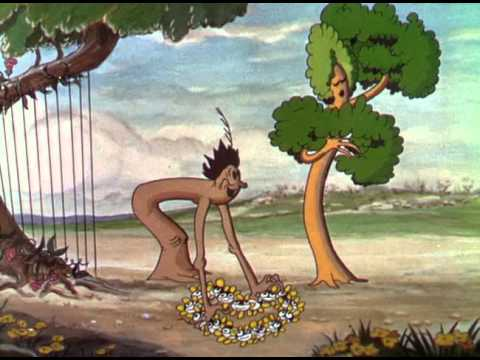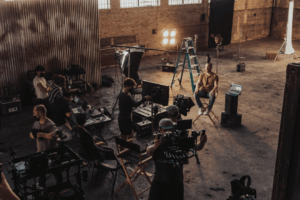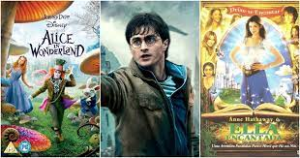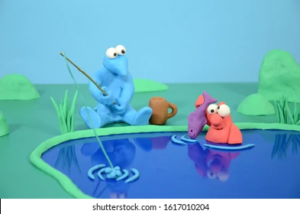Did you know that A Visit to the Seaside (1908) was the first commercially produced film in natural color? This eight-minute British short film used the Kinemacolor process to capture Brighton Southern England seafront shots. Also, we have La Vie et la passion de Jésus Christ (1903) which has a few scenes hand-colored. Though it is a series of 32 scenes and not a movie completely that featured colors, still, it marks a record in the history of color movies. With Our King and Queen Through India (1912) is the first full-length natural color documentary instead of traditional hand-colored techniques. Finally, we have The World, the Flesh and the Devil (1914) represented as the first feature-length narrative film in natural color to date.
Amazing Colour Footage From (1908 – 1912) – “A Visit to the Seaside” / “Atlantic City” HD
La Vie et la passion de Jesus Christ (Passion and Death of Christ) (1903)
THE WORLD, THE FLESH AND THE DEVIL Full Movie (1914) Watch Online Free – FULLTV
Nowadays, while we sit on our leather couches, watching movies on 60-inch HD televisions that allow us to examine all the pores on the faces of our celebrity heroes, it’s difficult to remember that it wasn’t always feasible to make movies in color. For most individuals, the age of black and white gives a very distinct dividing line between eras.
It is the most visible and instant indication that something we came across when browsing through the programs is not just old but highly ancient. While many of the finest films ever made were without color, including one of the best horror films of all time, there are still many individuals who would never push themselves to watch a black-and-white film. So, when did movies transition from black-and-white to color? And what triggered it?

One of the most common myths regarding cinematic history is that color was first used in the 1930s. While this is true at some level, filmmakers began experimenting with color in their films a little earlier. So what was the first color film, and how did they incorporate color into cinema before the groundbreaking process of Technicolor? What was the pioneering process used by Technicolor? What exactly is Technicolor? Don’t worry; we’ll cover all of these topics and more in this post.
The world’s oldest colour film discovered in Bradford (circa 1902)
The First Color Film
Many consider The Wizard of Oz as the first color film in cinema history. While this is strictly incorrect, we shall discuss why it is a prevalent misconception in a moment.
But first, let’s go back in time to learn the answer to the question, “What was the first color movie?”
The Early Days of Color Filmmaking
Before the Kinemacolor process, filmmakers employed more time-consuming and expensive methods to impart color to the film. Yet, surprisingly, color films are older than most people believe. For example, tinting represented color in film in early motion pictures, displaying a monochromatic image.

Many early filmmakers and innovators used stenciling or hand coloring of film images. For example, every shot of the movie Trip to the Moon (1902) required a complete assembly line of people to color. By looking at the film’s video, you can realize how difficult this effort was.
Astonishingly, a film could have this much color in the early twentieth century. Still, it’s challenging to comprehend how these color processes evolved into the coloring and color theory that we see today. How did these old-school coloring techniques grow into what we see now on the big screen? Kinemacolor pioneered color technology in film.
A Trip To The Moon (1902): Film History
Kinemacolor
A Trip to the Moon was the first known film to employ the Kinemacolor process effectively (1902). The Kinemacolor process was groundbreaking. To imitate the film’s colors, it used red and green filters on alternate frames.
While the Kinemacolor process opened up new avenues for color in cinema, it still did not depict the entire color spectrum on screen. As a result, some photos were washed out due to only red and green filters. In addition, images were missing a portion of the color spectrum due to a lack of blue.
A Concise History of Color Films and Early Color Experiments
Technicolor, an American business, developed its two-color process in 1917, used to shoot the first U.S. color picture, “The Gulf Between.” Still, the technology never gained popularity due to cost concerns. Meanwhile, Famous Players-Lasky Studios (later to become Paramount Pictures) developed their coloring technique (the Handschiegl color process), employing dyes in the 1917 picture “Joan, the Woman.” While it was also limited in utility and efficiency, it served as the foundation for future technological improvements.

“Toll of the Sea,” released in 1922, was the first to use a little more advanced Technicolor technique that imprinted the color on the actual film. But, unfortunately, it was rarely worth the extra cost while it was an upgrade. As a result, it was only utilized infrequently, often for a few moments within an otherwise black-and-white film, such as 1925’s “The Phantom of the Opera.”
How Technicolor changed movies
A Color History in Condensed Form
The most important thing to understand is that, while most movies were filmed on black-and-white film initially, it was always feasible to modify that celluloid to generate color; the color film has been available for nearly as long as moving images. Photographers retouched their black-and-white portraiture and sceneries in the nineteenth century to make them appear more realistic. (Though the result could be somewhat strange.) So, not long after the invention of the cinema, filmmakers began retouching their film stock.
Before the introduction of Technicolor, the numerous schemes for introducing pigment into the picture included:
- Hand-coloring each frame.
- Stenciling.
- Tinting.
The History and Science of Color Film: From Isaac Newton to the Coen Brothers
Hand-Coloring: Coloring in the Lines
The first type of cinema shading was hand coloring. Surprisingly, it was done just as the name says. Each image of each copy of the tape was hand-colored by painters. This time-consuming process was only conceivable because the first films were relatively short, only a few 100 feet in celluloid height. Therefore, they focused on high-quality early movies, such as Marie-Georges-Jean Méliès’ fantasy creations.
Stenciling and Coloring in the Lines
Stenciling was used in landmark films such as The Birth of a Nation (1915) and Intolerance (1916), and it was significantly easier than hand-coloring, albeit it was still quite labor-intensive. It involved etching glass panels with the layout of the primary photographic forms and then using these panels as master stencils that coated portions of the film so that colored dye could be applied to suitable areas of each frame. It was used primarily by the French Path corporation and marketed as PathColor.
Completely Tinted
Tinting was perhaps the most used coloring technique. This low-cost method of generating color in film stock entailed coloring the entire frame of a picture or sequence to fit the mood or activity of the scene: a yellowish-sepia for a lantern-lit cabin, a fiery red for combat, or hell, a dark blue for night, and so on. This approach was employed from very early on. For example, in films such as The Great Train Robbery (1903), until relatively late, in projects such as Portrait of Jennie (1948).
Birth of an Art: The History of Color in Film
Breakthrough and Beyond in Technicolor

In 1932, the Disney animated short “Flowers and Trees” employed Technicolor’s latest discovery (the three-dye transfer method). Then, in 1934, “The Cat and the Fiddle” became the first real-time picture to use this innovative new process. Although the costly method and the patent cameras that Technicolor was only able to license out meant that color was reserved for just the most significant big-budget pictures until about well into the 1950s, this is regarded as the beginning of actual color filmmaking.
1932 Silly Symphony Flowers and Trees July 30, 1932
Eastman Kodak had developed a technology comparable to Technicolor by the 1950s, and by the late decade, further developments by both had substantially lowered the cost of shooting in color. Color’s popularity began to surge at this point, and by the mid-1960s, black and white were only being used as an artistic choice.
As a result, most people regard the 1960s as the beginning of the color period. It was undoubtedly the point at which most movies transitioned to color. However, most people would be surprised to find that film first included the rudimentary beginnings of color technology in 1902.
The Temptation of Color Movies
The dye-transfer technique cemented Technicolor’s dominance in color film for more than two decades. The procedure was utilized in Gone With The Wind (1939), The Adventures of Robin Hood (1938), and Disney’s Snow White (1937). In 1939, Technicolor was also given credit for The Wizard of Oz. Many of the film’s famous elements were dictated by the Technicolor process, which Victor Fleming directed. For example, the famed ruby slippers were initially silver, but creators felt the jewel tone would look better. Jello powder was also used to dye horses, resulting in bright colors. Employees from Technicolor were present on set to achieve the most satisfactory possible outcomes. Temperatures on stage could reach 100 degrees due to the studio lighting used.

The Wizard of Oz ushered in a new era in how filmmakers and the general populace viewed color. Dorothy lives in sepia-toned Kansas at first. Although sepia was indicative of a country emerging from the Great Depression and Dust Bowl, the footage was not black and white. The entire set, as well as Dorothy’s outfits, were done in sepia tones. When Dorothy steps out of her tornado-ravaged house into Oz, a sepia-covered duplicate gazes out in awe. She suddenly steps aside, revealing a colorfully costumed Judy Garland. The early fears of filmmakers that color would distract the viewers were unfounded. Color became an integral component of the plot and a vital storytelling device.
The Dye Transfer Printing Process – Technicolor 100
Innovation and Competition
Until the 1950s, Technicolor’s dominance in color film production remained nearly unchallenged. Color films had become considerably more popular, and less expensive processes had been accessible. “Color by Technicolor” remained the gold standard, although Eastmancolor by Kodak and Anscocolor by Ansco provided less expensive filming options. Instead of three reels of triple-emulsion film, these systems used only one reel.
Technicolor leaned on its superior color and clarity to stay relevant. The company started converting films shot on various film types to Technicolor reels suited for distribution. Technicolor redesigned their heavy three-strip cameras to film in the popular wide-screen movie format, demonstrating business forethought. Technirama provided high-quality, compressed color images that could be magnified by projection.
Technicolor’s dye-transfer technique was phased out in the 1970s after a nearly 50-year run. However, in the 1980s, the business popularized ENR, a “silver-retention” chemical technique for a film. Many contemporary directors have employed the method, which can be observed in films like Steven Spielberg’s Saving Private Ryan. With digital filming in modern studios, Technicolor has restored classic movies and entered numerous fields of digital media in the twenty-first century. However, the firm that characterized the bright, vibrant color is still well-known.
Cinematography: The Language of Colour || Vittorio Storaro
Legacy
The evolution of color motion pictures, spearheaded by Technicolor, spans three generations of moviegoers. Cinematography’s fast-changing technology frequently clearly dates films, eliciting nostalgia or laughter at bygone advances. Nevertheless, Technicolor inspired American films for a century, and the company’s name has extended beyond itself. The continuous use of “technicolor” as a descriptor of all things brilliant and colorful attests to their technology’s long-lasting impact on American cultural vocabulary.
The First Technicolor film was a Fiasco a Century Ago
Looking back at “The Gulf Between,” an intriguing but tragic filmmaking attempt that stretched technological frontiers. It has the potential to teach today’s 3D films a thing or two.
Lights, Camera… Mishap
Carl Alfred “Doc” Willett, Technicolor’s seasoned production manager, brought in a relatively inexperienced – and so easily controlled – 27-year-old filmmaker, Wray Bartlett Physioc, to helm “The Gulf Between.” Niles Welch, a vaudeville and Broadway performer, and Grace Diamond, a Canadian actress who subsequently became notorious for her affair with fellow actress Jean Acker, lead the cast.

Because Technicolor filming requires a lot of natural light, the production moved to Jacksonville, Florida, in December 1916. Because of its bright skies most of the year, Jacksonville was a desirable filming location for the expanding motion picture industry. Even the indoor scenes in the film were shot on open-air sets to catch as much light as possible.
Jacksonville was also only a 30-hour rail ride from New York. The Technicolor team arrived in style, stripping a Boston & Maine sleeper freight car and outfitting it with a cutting-edge film processing lab, power plant, and office, replete with a fireproof safe for film storage. It was like a souped-up train car from “The Wild Wild West” on a wild ride through a new frontier: color cinema.
The first issue arose shortly.
It had to be colored before use to make the film more delicate, but the train car’s lab generated cloudy and useless film. Comstock was sent to Florida within two weeks to resolve the issue, or the funders would pull the plug.
With only one day till Comstock’s deadline, the team pinpointed the source of their problems as tainted hydrogen peroxide. However, the shooting went on. The new approach of filming in color necessitated trial and error. For example, they experimented with excessive makeup but discovered that mild makeup worked better. Other issues included frequent power interruptions and endless reshoots.
Filming continued through March 1917 and then into April 1917. Diamond and Welch wouldn’t return to New York until late May.
First Color Film In India

Kisan Kanya was the first color film made in India in 1937, even though the popularity of color films began much later. Moti B. Gidwani directed the picture, which Imperial Film Co-produced. Ram Gopal Pandey created the soundtrack for the film, and Gramophone Records published ten tracks from the movie. The film’s plot revolved around an exploitative landowner and Ramu, a friendly farmer suspected of murdering the landlord. Imperial Film Co. Imported the Cinecolour process to colorize the film. Kisan Kanya ran for 137 minutes and starred Padmadevi, Jillo, Ghulam Mohammed, Nissar, Syed Ahmed, and Gani.
Videos
The Stunning Evolution of Color in Films
Kisan Kanya, the First Color Film in India
Kodak 1922 Kodachrome Film Test













